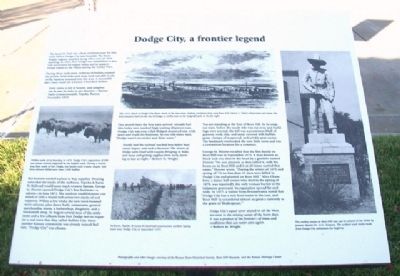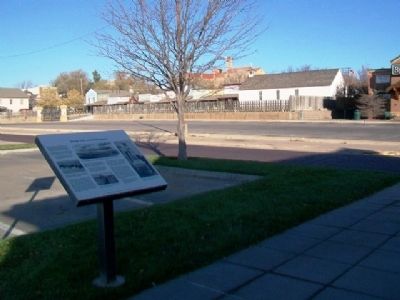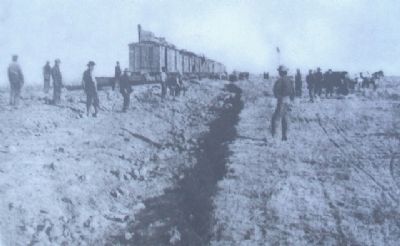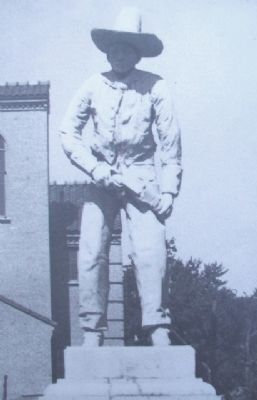Dodge City in Ford County, Kansas — The American Midwest (Upper Plains)
Dodge City, a frontier legend
The Santa Fe Trail was a busy overland route for fifty years before Dodge City was founded. The heavy freight wagons rumbled along where you are now standing. In 1865, Fort Dodge was established to provide protection for wagon trains and to support troops based on the Plains during the Indian Wars.
During those early years, millions of buffalo roamed the prairie. With hides and meat both valuable in the 1870s, hunters swarmed over the area. A successful day's hunt could net a hunter a hundred dollars.
Every ravine is full of hunters, and campfires can be seen for miles in any direction.
- Kansas Daily Commonwealth, Topeka, Kansas,
November 1872
But hunters needed a place to buy supplies. Hearing news that the tracks of the Atchison, Topeka & Santa Fe Railroad would soon reach western Kansas, George M. Hoover opened Dodge City's first business - a saloon - in June 1872. His outdoor establishment consisted of only a board laid across two stacks of sod supports. Within a few weeks the new town boasted more saloons, plus dance halls, restaurants, general merchandise stores, a barbershop, drugstore, and a blacksmith shop. In August several men of the settlement and a few officers from Fort Dodge met to organize a real town that they called Buffalo City. Since another Kansas community was already named Buffalo, "Dodge City" was chosen.
One month later the first train arrived. Already buffalo hides were stacked high waiting shipment east. Dodge City was now a full-fledged chartered city, wide open and ready for business. As one old-timer said, "Dodge warn't no nickel and dime town."
Hardly had the railroad reached here before businesses began; and such a business! The streets of Dodge were lined with wagons bringing in hides and meat and getting supplies from early morning to late at night.
- Robert M. Wright
You are standing at the foot of Boot Hill. In its original state, before the south side was cut away and buildings were erected, the hill was a prominent bluff of gypsum, rock, clay, and sand, covered with buffalo grass, clumps of soapweed, and prickly pear cactus. The landmark overlooked the new little town and was a convenient location for a cemetery.
George M. Hoover recalled that the first burial on Boot Hill was in September 1872. A man known as Black Jack was shot in the head by a gambler named Denver. "He was planted, as they called it, with his boots on in Boot Hill and it at all times carried that name." Hoover wrote, "During the winter of 1872 and spring of '73 no less than 15 men were killed in Dodge City and planted on Boot Hill." Alice Chambers, a dance hall owner who died in the spring of 1878, was
reportedly the only woman buried in the infamous graveyard. Its reputation spread far and wide. In 1877, a visitor from Pennsylvania noted that "Dodge City has a very hard name in the east, and 'Boot Hill' is considered almost as great a curiosity as the grave of Shakespeare."
Dodge City's equal never existed in all the West, not even in the mining camps of the boom days. It was a product of the frontier - of times and conditions that can never exist again.
- Robert M. Wright
Photographs and other images courtesy of the Kansas State Historical Society, Boot Hill Museum, and the Kansas Heritage Center
Topics. This historical marker is listed in these topic lists: Industry & Commerce • Railroads & Streetcars • Settlements & Settlers • Wars, US Indian. A significant historical month for this entry is June 1872.
Location. 37° 45.184′ N, 100° 1.25′ W. Marker is in Dodge City, Kansas, in Ford County. Marker is on Wyatt Earp Boulevard west of 3rd Avenue, on the right when traveling west. Marker is at the Dodge City Visitor Center. Touch for map. Marker is at or near this postal address: 400 West Wyatt Earp Boulevard, Dodge City KS 67801, United States of America. Touch for directions.
Other nearby markers. At least 8 other markers are within walking distance of this marker. Boot Hill Cemetery (within shouting distance of this marker); The Boot Hill Special (about 300 feet away, measured in a direct line); Dennis Weaver
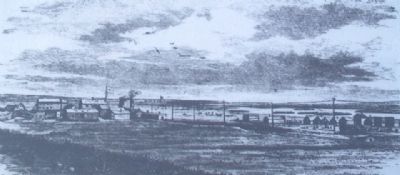
Photographed By Unknown, 1872
3. Image on Dodge City, a frontier legend Marker
Also see . . .
1. History of Dodge City, Kansas. (Submitted on May 11, 2013, by William Fischer, Jr. of Scranton, Pennsylvania.)
2. A Cowboy in Dodge City, 1882. (Submitted on May 11, 2013, by William Fischer, Jr. of Scranton, Pennsylvania.)
3. Dodge City, Ford County, Kansas. (Submitted on May 11, 2013, by William Fischer, Jr. of Scranton, Pennsylvania.)
Credits. This page was last revised on March 22, 2021. It was originally submitted on May 11, 2013, by William Fischer, Jr. of Scranton, Pennsylvania. This page has been viewed 834 times since then and 23 times this year. Photos: 1, 2, 3, 4, 5. submitted on May 11, 2013, by William Fischer, Jr. of Scranton, Pennsylvania.
